
P-ISSN 1859-3585 E-ISSN 2615-9619 https://jst-haui.vn ECONOMICS - SOCIETY Vol. 60 - No. 11E (Nov 2024) HaUI Journal of Science and Technology
137
RESEARCH ON FACTORS AFFECTING THE APPLICATION OF ENTERPRISE RESOURCE PLANNING SYSTEM (ERP) IN TEXTILE AND GARMENT INDUSTRY IN VIETNAM
Tran Tu Uyen1,*, Bui Thu Phuong1 DOI: http://doi.org/10.57001/huih5804.2024.352 1. INTRODUCTION In recent years, the fourth industrial revolution, or Industry 4.0, has been the focus of global discussions. To succeed in today's fiercely competitive environment, businesses must adapt quickly [20]. As a result of the strong integration of technology, a wave of new IT system deployment is spreading throughout the business world. Among them is ERP (Enterprise Resource Planning) software, or human resource planning system, one of the strongest enterprise applications. Textile and garment are one of the most crucial industries in Vietnam’s economy with a large export turnover in Vietnam [14]. To be able to compete with countries with developed textile industries such as China, India ..., Vietnamese textile enterprises must solve important issues such as production optimization, cost reduction., computerizing enterprises. Therefore, this is considered an exciting period for the ERP market in Vietnam textile and garment. Every year, Panorama Group - an enterprise specializing in ERP software consultancy - conducts surveys ABSTRACT
In the 4.0 revolution industry, developed countries have applied enterprise resources planning, which
aggregates all data from different processes and store it in a centralized database allowing the use of
information in a variety of ways for managers. How
ever, in Vietnam, specifically textile companies, ERP is
much less applied. After researching and studying the characteristics of Vietnamese textile companies, the
author finds that the application of Enterprise Resources Planning (ERP) is likely to be the
appropriate method
to bring significant benefits to businesses, especially textile manufacturers. The objectives of the study are
determining factors and the level of impact of each factor on the application of ERP systems in textile
enterprises in Vietna
m. Six factors that affect the application of ERP in Vietnam textile companies by
Regression Model have been found out, including support from senior management, effective project
management, change management, support from consulting companies, training,
and users. All factors have
a positive impact on the successful application of ERP. The influence level of factors in order of decreasing
importance: support from senior management, effective project management, change management, support
from consulting f
irms, training, and user. From that, it can be concluded that the factor “Support from senior
management” has the greatest influence on the successful application of the ERP system in the textile
industry in Vietnam and the “User” factor has the least amou
nt of influence. The most influential of the six
factors analyzed for the successful application of the ERP system to the textile industry in Vietnam. According
to Tabachnick and Fidell, for multivariate regression analysis, the minimum sample size (N) to
be achieved is
calculated by the formula: N = 50 + 8*m (m is the number of independent factors). In this study, there are 6
independent factors, so the minimum number of samples will be: N = 50 + 8*6 = 98 (sample). After
screening the total obtained survey
s, removing invalid surveys (same answers from beginning to end, leaving
many questions blank), the sample size for the analysis is 108 samples. This paper has summarized some
personal characteristics from the results collected from 108 survey samples as f
ollows: Regarding the ERP
software used by textile and garment enterprises in Vietnam, 3 ERP system providers account for the largest
market. The major market share is SAP (45.4%), Oracle (34.3%), Microsoft Dynamic (11.1%), and the rest are
other software
(9.2%). Based on the research results, some solutions can be offered to enhance the successful
applicability of ERP in Vietnamese textile companies. Keywords: Enterprise Resources Planning (ERP), regression model, centralized database. 1Foreign Trade University, Vietnam *Email: uyentt@ftu.edu.vn Received: 16/5/2024 Revised: 25/7/2024 Accepted: 28/11/2024

ECONOMICS - SOCIETY https://jst-haui.vn HaUI Journal of Science and Technology Vol. 60 - No. 11E (Nov 2024)
138
P
-
ISSN 1859
-
3585
E
-
ISSN 2615
-
961
9
on the implementation of ERP projects of businesses around the world. In the 2019 ERP Report [38], Panorama surveyed businesses that have been implementing ERP applications. Among them, about 45% of the projects exceeded the initial budget and 58% exceeded the original schedule. The percentage of users who are satisfied with the application of ERP software tends to increase with the rate of 88% of users satisfied compared to 68% of statistics in 2018. Regarding the implementation budget, up to 45% of the projects exceed the original budget. Compared to Panorama’s 2018 ERP Report (64%) [39], this is a positive change because it shows that businesses can evaluate more realistically the time, effort, and resources needed to deploy ERP. The implementation of ERP software exceeded the budget due to many reasons such as scope expansion (43%), low expected consulting fee (38%), technical or organizational issues (33%). In terms of implementation time, up to 58% of projects are late. This is similar to the deployment budget, with a much higher rate of delays than on-time in deploying ERP software. Delay has many causes such as unrealistic project time (48%), data problems (41%), expanding project scope (41%). According to Panorama’s experience, the deployment is beyond the set time due to the late addition of resources or lack of guidance from the implementing units. In addition, the action plan for implementing, managing organizational change, improving business processes are also reasons for the delay in the deployment of ERP software. Successfully deploying ERP software to gain benefits when applying ERP is not a simple task. After researching and understanding the characteristics of Vietnamese textile enterprises, the author found that the application of ERP system suitable for researching textile enterprises aims to achieve the following three specific objectives: Identifying factors affecting ERP application to textile enterprises in Vietnam; Determining the impact of each factor on the application of ERP system to textile enterprises in Vietnam. From the results of the analysis, the author proposes several recommendations to help managers of textile enterprises in particular and enterprises in Vietnam in general to improve the ability to successfully apply the ERP system to businesses. The structure of the paper consists of 5 parts, including an introduction, an overview of past research, research method, research results, conclusion, and recommendations. 2. OVERVIEW OF PAST RESEARCH There has been a lot of research on enterprise resource planning systems ERP, from many different angles. In ERP enterprise management, it is understood that “a system consists of a commercial software package that promises seamless integration of all information flowing through the company, finance, human resources, chains supply and customer information” [8]. According to the research of Helmut, Michael & Guy [15], ERP is a commodity, a product in the form of computer software, and an important means of providing business solutions for businesses. ERP is not only a software solution but also a strategic business solution for businesses. According to Olson [17], ERP is a software component that helps businesses plan and manage important parts of the business process including production planning, purchasing, inventory management, dealing with suppliers, providing customer service, and tracking orders. In the research of Aernoudts et al. [1], ERP gathers all data from different processes and stores it in a centralized database that allows the use of information in a variety of ways. In another study, empirical research on the factors affecting user acceptance of ERP systems - focusing on small and medium enterprises in Vietnam, ERP systems try to integrate. All business processes into one set of applications, processes, and metrics are synchronized to improve data consistency and integration of modular applications [12]. ERP is a system to help streamline, improve and develop businesses, but the successful application of an ERP enterprise resource planning system is affected by many factors. Many studies have been done in identifying factors to make ERP projects successfully implemented. In this paper, most information was available on previous studies, with additional studies that specified the Textile industry in Vietnam. Some contributions to the literature from the findings of the paper are 6 main factors affecting the application of the ERP system in the textile industry in Vietnam and the actual status of the impact of each factor. for the ERP system application process. 6 significant factors are support from senior management, effective project management, change management, support from consulting companies, training, and users. All factors have a positive impact on the successful application of ERP. The influence level of factors in order of decreasing importance: support from senior management, effective project management, change management, support

P-ISSN 1859-3585 E-ISSN 2615-9619 https://jst-haui.vn ECONOMICS - SOCIETY Vol. 60 - No. 11E (Nov 2024) HaUI Journal of Science and Technology
139
from consulting firms, training, and user. From that, it can be concluded that the factor “Support from senior management” has the greatest influence on the successful application of the ERP system in the textile industry in Vietnam and the “User” factor has the least amount of influence. From the research results, enterprise resource planning (ERP) systems have been beginning to be interested in textile companies in Vietnam, but the level of willingness to apply ERP systems of textile enterprises in Vietnam is still low. ERP systems help to consolidate data of departments and centralize data management for textile companies to apply, thereby helping leaders and managers of textile enterprises to make more effective and accurate decisions, more effective in managing employees. The rate of ERP system application in textile companies in Vietnam is not high, most of the cost of implementing ERP system application projects in textile enterprises in Vietnam is still high. According to the situation of small-scale textile and garment enterprises, limited investment capital, enterprises face many difficulties to invest in ERP projects, when the large scale of investment capital as opposed to their financial capacity limit. 3. RESEARCH METHOD 3.1. Building the research model In the past, there have been many studies showing the factors affecting the application of enterprise resource planning (ERP) systems. The factor research direction was first used by Rockart and then widely applied in many aspects of information technology project management such as: implementing warehouse management, management, production,…. In the field of ERP application, knowing the influencing factors will help to better organize the project implementation, thereby ensuring the success of the project. The results of the studies have also been examined in projects carried out in various countries including developing and developed countries [2, 6, 24-29, 33]. Factors explored such as goal definition, user engagement, change management, project management, leadership support, process change, communication, quality, team consulting. Based on the actual situation in Vietnam combined with other domestic and foreign studies, the author built a model of 6 factors affecting the application of ERP enterprise resource planning system in companies. Textile and apparel include support from top management, effective project management, change management, support from ERP software consultancy, training, and users, specifically as follows: Support from senior management Support from senior management is active support from management in providing resources, project commitment, leadership involvement in solving project issues when there is a problem. arising [10]. Management should understand each level of support for change and support [7]. Leadership support was once considered the most important and confirmed factor in the research of Western countries [5, 26-29, 31, 33, 34]. H1: The greater the support from senior management, the more successful the ERP application project in the textile industry in Vietnam. Effective project management ERP projects are complex, so an effective management strategy is needed to control their implementation [33]. Project management is the process of monitoring and control throughout the project's life cycle, which involves the use of skills and knowledge in planning and monitoring tasks to achieve set goals of the project, achieve employee commitment, and organize the implementation process [4]. Therefore, a detailed project plan associated with the goal needs to be determined. Project management is considered an important factor determining the success of the project [2, 28, 30, 31, 32, 34]. H2: The more effective project management is, the more successful the ERP application project in the textile industry in Vietnam. Change management Implementing an ERP system involves standardizing old business processes into new standard processes according to different technologies [5]. Therefore, organizations need to be ready to change their processes to fit the process designed on the ERP software, minimizing edits on the ERP. Too much editing on the ERP will cause the system to generate uncontrollable errors, reducing the effectiveness of the ERP application. Process standards and software modification mitigation have been discussed by researchers [5, 26-28, 31, 34, 36] define process standardization as a review and redesign of business processes to achieve improved, more efficient results such as on cost, quality, and speed. H3: The better the change management, the more successful the ERP application project in the textile industry in Vietnam.

ECONOMICS - SOCIETY https://jst-haui.vn HaUI Journal of Science and Technology Vol. 60 - No. 11E (Nov 2024)
140
P
-
ISSN 1859
-
3585
E
-
ISSN 2615
-
961
9
Support from ERP software consulting firm The ERP product provider should have a good working relationship with the ERP application company, offering quality services within a reasonable amount of time, providing users with business knowledge and expertise on how ERP is used, as well as providing documentation, operational documents, and other necessary documents for the use of ERP [11]. Every business has different needs, and each provider has different solutions. It is likely that they do not fully meet the needs of the business, especially when the business process of the business is unique. Therefore, to increase the chance of success, management must choose the software that best suits the requirements of the business. ERP vendors use different hardware platforms, databases, and operating systems, and some of this packaged ERP software is only compatible with some businesses. Therefore, businesses should first conduct requirements analysis to ensure that the issues that need to be addressed and customized ERP software are tailored to the business [34]. H4: The better the support from ERP software consulting firms, the more successful the ERP application project in the textile industry in Vietnam. Training According to Nelson and Cheney [16], there is a positive connection between employee training and their ability to use computer or technology-related products. A series of studies have shown a link between the satisfaction of ERP software users and their complete training in ERP software. Another study by Gartner Group also shows that businesses should spend 25% of the ERP project funding for user training. Shortening and spending less on training time will be counterproductive in the long run. Training refers to the process of providing managers and employees with the overall concept of ERP software. As a result, users have a better understanding of how their work relates to other functional departments within the enterprise [37]. H5: The more thorough the training, the more successful the ERP application project in the textile industry in Vietnam. Users User participation in the deployment process increases their level of satisfaction and confidence in the ERP system. According to Zhang et al. [34], the company should allow users to participate in the deployment project right from the requirement identification stage, followed by participation in the deployment stage. As users participate and deploy, they get used to the system and understand the system faster, thus helping them feel less difference between the old and new systems. Moreover, this helps users to contact the system early and when entering the training phase, they will not feel strange and difficult anymore. Once you understand the process and the business, users will no longer need consultants, which helps reduce costs for the company. From there they can also re-educate those new to the ERP system. In addition, users participate in system implementation more effectively because it enhances cognitive control through participation in overall project plans [34]. H6: The higher the user's capacity, the higher the success of ERP application projects in the textile industry in Vietnam. The author proposes a research model as Figure 1. Figure 1. Model of factors affecting ERP application Sources TC = β0 + β1LĐ + β2DA + β3TĐ + β4TV + β5DT + β6ĐT + ε In which: β0 is the regression constant β1, β2, β3, β4, β5, β6 are the regression coefficients ε is the random error. Independent variables: (1) LD: Support from senior leaders; (2) Project: Effective project management; (3) TD: Change management; (4) TV: Support from ERP consulting firm; (5) Tel: Training; (6) SD: User Dependent variable: TC: Successful application of ERP.

P-ISSN 1859-3585 E-ISSN 2615-9619 https://jst-haui.vn ECONOMICS - SOCIETY Vol. 60 - No. 11E (Nov 2024) HaUI Journal of Science and Technology
141
3.2. Data collection In the survey, the author sent questionnaires to respondents by live-streaming or via the website, email. At the same time, the questionnaire was designed on Google Docs and sent via emails to the survey respondents, who are working at textile enterprises that have been applying ERP systems in Vietnam. The survey questionnaires are divided into 2 parts. The first part consists of three questions to find out information about textile companies in Vietnam such as company name, the ERP system the company is using, and when the company applied the ERP system. The second part contains 25 questions investigating the factors affecting the successful application of enterprise resource planning (ERP) to textile enterprises in Vietnam. The survey was conducted in the period from 4/2020 to 6/2020, sent by the website, email to the Board of Directors, department heads, and employees involved in ERP application of 130 textile companies in Vietnam which have official websites and clear email addresses provided by the customer portfolio of ERP software consulting companies in Vietnam (BRAVO, Fast, FPT IS, Vietsoftware, Effect) in 2020. 4. RESEARCH RESULTS Table 1. Testing Cronbach’s Alpha reliability coefficient Observed Item Scale Mean if Item Deleted Scale Variance if Item Deleted Corrected Item - Total Correlation Cronbach’s Alpha if Item Deleted
Support from senior leadership (LD): Cronbach’s Alpha = 0.906
LD1 11.602
3.588
0.783
0.881
LD2 11.611
3.511
0.814
0.870
LD3
11.519
3.392
0.779
0.882
LD4 11.630
3.319
0.782
0.881
Effective project management (DA): Cronbach’s Alpha = 0.852
DA1
15.278
5.193
0.568
0.846
DA2 15.222
4.866
0.706
0.811
DA3 15.241
4.521
0.755
0.796
DA4 15.037
4.802
0.719
0.807
DA5 15.222
5.240
0.577
0.844
Changing management (TD): Cronbach’s Alpha = 0.793 TD1 7.370
0.964
0.655
0.700
TD2 7.398
0.896
0.712
0.636
TD3
7.565
0.958
0.549
0.816
Support from consulting ERP firm (TV): Cronbach’s Alpha = 0.844 TV1 7.491
0.888
0.694
0.805
TV2
7.481
1.000
0.809
0.704
TV3 7.546
0.998
0.648
0.841
Training (DT): Cronbach’s Alpha = 0.839
DT1
11.241
2.091
0.707
0.781
DT2 11.130
1.927
0.707
0.780
DT3 11.333
2.037
0.644
0.809
DT4
11.074
2.219
0.634
0.812
User (SD): Cronbach’s Alpha = 0.817 SD1 7.343
1.050
0.742
0.671
SD2
7.176
1.380
0.588
0.831
SD3 7.315
0.947
0.711
0.714
Successful application of ERP (TC): Cronbach’s Alpha = 0.773
TC1 7.676
1.044
0.563
0.741
TC2 7.741
0.904
0.594
0.717
TC3
7.602
1.008
0.679
0.624
Sources: SPSS data processing results Regarding ERP software, textile and garment enterprises in Vietnam are using: Of the total 108 answers, 58 people chose SAP (accounting for 45.4%), 37 people chose Oracle (accounting for 34.3%); 12 people chose Microsoft Dynamics (11.1%), and the remaining 10 chose other software (9.2%). For using time of ERP system: Out of 108 responses, 1 person chose 1 year back level (accounting for 0.9%), 16 chose 1-2 years level (14.8%), 14 people chose 2-3 years’ level (accounting for 13.0%),14 people are choosing at 3-4 years level (accounting for



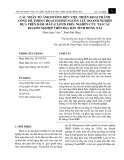
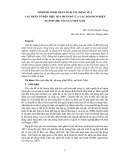
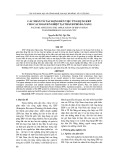
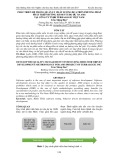
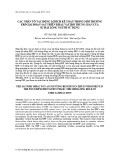
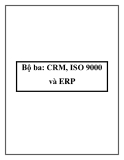




![Tối ưu hóa hiệu suất hệ thống: Bài thuyết trình [Chuẩn nhất]](https://cdn.tailieu.vn/images/document/thumbnail/2025/20251107/hiepdz2703@gmail.com/135x160/35941762488193.jpg)



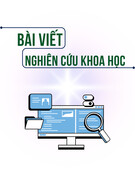
![Bài giảng Quản trị chất lượng trong công nghiệp thực phẩm [chuẩn nhất]](https://cdn.tailieu.vn/images/document/thumbnail/2025/20250805/vijiraiya/135x160/637_bai-giang-quan-tri-chat-luong-trong-cong-nghiep-thuc-pham.jpg)

![Đề cương bài giảng Kỹ năng hoạt động công nghiệp [mới nhất]](https://cdn.tailieu.vn/images/document/thumbnail/2025/20250715/kimphuong1001/135x160/76971752564028.jpg)


![Bài giảng Kỹ thuật điều độ trong sản xuất và dịch vụ [mới nhất]](https://cdn.tailieu.vn/images/document/thumbnail/2025/20250630/dcbaor/135x160/13121751251866.jpg)


